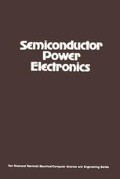Abstract
A knowledge of quantum mechanics and solid-state physics is necessary background for comprehending the details of the operation of semiconductor devices. However, for this text, it is sufficient to have a general understanding of transistor behavior. The following description is intended to present a physical explanation of bipolar transistor operation, which will provide the basis for power transistor application limitations and unique characteristics [1], [2].
Access this chapter
Tax calculation will be finalised at checkout
Purchases are for personal use only
Preview
Unable to display preview. Download preview PDF.
References
RCA Transistor, Thyristor and Diode Manual. Somerville, NJ: RCA Corporation, 1971, pp. 3–8.
Comer, Donald T. Large Signal Transistor Circuits. Englewood Cliffs, NJ: Prentice-Hall, Inc., 1967.
Searle, C.L., et al. Elementary Circuit Properties of Transistors. New York: John Wiley & Sons, 1964, pp. 6–7.
Comer, Donald T. Op. cit., pp. 21–26, 37–39.
Searle, C.L. Op. cit., pp. 37–54.
Ibid., pp. 21–24.
Comer, Donald T. Op. cit., pp. 28–34.
RCA Transistor, Thyristor and Diode Manual. Op. cit., pp. 12–15.
RCA Designer’s Handbook Solid State Power Circuits. Somerville, NJ: RCA Corporation, 1971, pp. 99–112.
Roehr, William D., et al. Switching Transistor Handbook. Phoenix: Motorola, Inc., 1970, pp. 14–23.
Hower, P. L. Optimum Design of Power Transistor Switches. IEEE Transactions on Electron Devices ED-20: April 1973, pp. 426–435.
Power Data Book. Mountain View, CA: Fairchild Camera and Instrument Corporation, 1976, chap. 1.
Owyang K., and Shafer, P. A New Power Transistor Structure for Improved Switching Performance. Washington, DC: IEEE International Electron Devices Meeting, December 1978. (Also available as General Electric Application Note 660.37.)
Pelly, Brian R. Power Semiconductor Devices—A Status Review. Orlando: IEEE/IAS International Semiconductor Power Converter Conference Record, 1982, pp. 1–19.
RCA Designer’s Handbook Solid State Power Circuits. Op. cit., pp. 113–149.
Hunter, Lloyd P., ed. Handbook of Semiconductor Electronics, 3d ed. New York: McGraw- Hill Book Company, 1970, pp. 19–8 through 19–15.
RCA Transistor, Thyristor and Diode Manual. Op. cit., pp. 17–37.
RCA Designer’s Handbook: Solid State Power Circuits. Op. cit., pp. 123–126.
Ibid., pp. 175–182.
Thyristor and Diode Manual. Op. cit., pp. 30–35.
RCA Designer’s Handbook: Solid State Power Circuits. Op. cit., pp. 126–134.
The Power Semiconductor Data Book for Design Engineers, 1st ed. Dallas: Texas Instruments, Inc., pp. 11–4 through 11–17.
Power Data Book. Mountain View, CA: Fairchild Camera and Instrument Corporation, 1976, chap. 2.
Ghandi, Sarab K. Semiconductor Power Devices. New York: John Wiley & Sons, 1977, pp. 172–183.
Hawkins, H.R. Mechanisms of Secondary Breakdown in Power Transistors. Kokomo: Delco Electronics, May 12, 1977.
Bennett, Wilfred P., and Kumbatovic, Robert A. Power and Energy Limitations of Bipolar Transistors Imposed by Thermal-Mode and Current-Mode Second-Breakdown Mechanisms. IEEE Transactions on Electron Devices ED-28: October 1981, pp. 1154–1162.
SCR Manual, 6th ed. Auburn, NY: General Electric, 1979, pp. 37–42.
Gutzwiller, F. W., and Sylvan, T. P. Power Semiconductors Under Transient and Intermittent Loads. AIEE Transactions, Part I, Communications and Electronics, January 1961, pp. 699–706.
Westinghouse Silicon Power Transistor Handbook. Youngwood, PA: Westinghouse Electric, 1967, pp. 2–19 through 2–22.
Hower, P. L., and Tarneja, K. S. The Influence of Circuit and Device Parameters on the Switching Performance of Power Transistors. Power Conversion International 6, July/August 1980, pp. 10–22.
Author information
Authors and Affiliations
Rights and permissions
Copyright information
© 1986 Van Nostrand Reinhold Company Inc.
About this chapter
Cite this chapter
Hoft, R.G. (1986). Diodes and Power Transistors. In: Semiconductor Power Electronics. Van Nostrand Reinhold Electrical/Computer Science and Engineering Series. Springer, Dordrecht. https://doi.org/10.1007/978-94-011-7015-4_2
Download citation
DOI: https://doi.org/10.1007/978-94-011-7015-4_2
Publisher Name: Springer, Dordrecht
Print ISBN: 978-94-011-7017-8
Online ISBN: 978-94-011-7015-4
eBook Packages: Springer Book Archive

